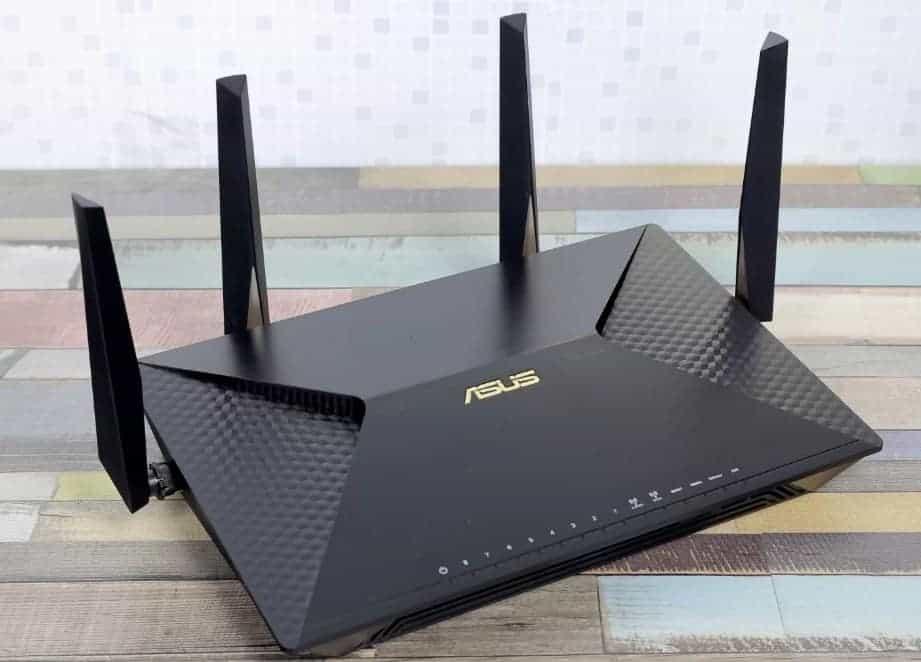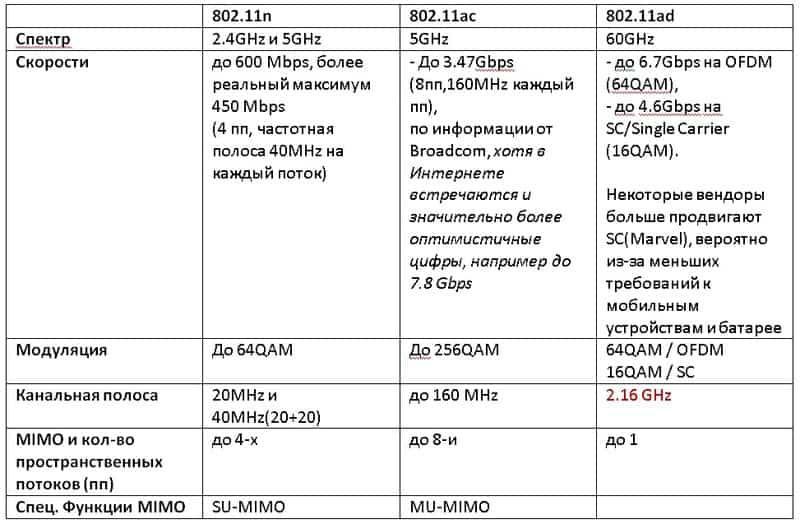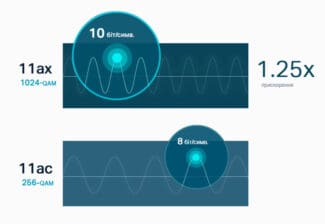In this chapter, we'll talk about using this standard at home. As you have probably already realized, the main "Achilles' heel" is the range. For a small apartment it is enough, but in a large country house you will have to put repeaters. I can give you a vivid example of its use.
AC standard Wi-Fi. Why AC router is better than N router
When you buy a 5GHz router, the word DualBand distracts our attention from the more important point, the Wi-Fi standard that uses 5GHz carrier. Unlike the 2.4GHz carrier standard that we already know and understand, 5GHz devices can be used in conjunction with 802.11n or 802.11ac standards ( hereinafter AC standard and N standard).
The IEEE 802.11 group of Wi-Fi standards has evolved quite dynamically, from IEEE 802.11a, which provided speeds up to 2 Mbps, through 802.11b and 802.11g, which gave speeds of up to 11 Mbps и 54 Mbps respectively. Then 802.11n or simply the n-standard appeared. The N-standard was a real breakthrough, because it was possible to transmit traffic at the then unthinkable speed of 150Mbps. This was achieved by using advanced coding technology (MIMO), more careful attention to RF propagation, double channel width technology, a non-static guard interval defined by such concepts as modulation index and coding schemes.
Operating Principles of 802.11n
The familiar 802.11n can be used in either of the 2.4GHz and 5.0GHz bands. On the physical layer, in addition to improved signal processing and modulation, it adds the ability to transmit simultaneously over four antennas, through each antennae can transmit up to 150Mbit/s, i.e. it is theoretically 600Mbit. However, given that the antenna is simultaneously working either for reception or for broadcasting, the data rate in one direction will not exceed 75Mbit/s per antenna.
Multichannel Input/Output (MIMO)
This technology was first available in 802.11n. MIMO stands for Multiple Input Multiple Output, which stands for Multiple Input Multiple Output.
MIMO allows multiple data streams to be simultaneously received and transmitted over more than one antenna.
The 802.11n standard defines different antenna configurations from "1×1" to "4×4". Non-symmetric configurations are also possible, such as "2×3" where the first value means the number of transmitting and the second the number of receiving antennas.
Obviously, the maximum transmission reception rate can only be achieved by using the "4×4" scheme. Actually, the number of antennas does not increase the speed by itself, but it allows the application of various advanced signal processing methods, which are automatically selected and applied by the device, including based on the configuration of antennas. For example, the "4×4" scheme with 64-QAM modulation provides speeds up to 600 Mbit/s, the "3×3" and 64-QAM scheme provides speeds up to 450 Mbit/s, and the "1×2" and "2×3" schemes up to 300 Mbit/s.
Channel bandwidth of 40 MHz
A feature of 802.11n is a feature of the 802.11n standard is the doubled bandwidth of the 20 MHz channel, i.e. 40 MHz. 802.11n can be supported by devices operating on 2.4GHz and 5GHz carriers. While 802.11b/g only works at 2.4 GHz, 802.11a works at 5 GHz. In the 2.4 GHz band only 14 channels are available for wireless networks, of which the first 13 are allowed in the CIS, with 5 MHz intervals between them. Devices using 802.11b/g use 20 MHz channels. Of the 13 channels, 5 are overlapping. To avoid mutual interference between channels, it is necessary that their bands are separated from each other by 25 MHz. That is, only three channels on the 20 MHz band will be non-overlapping: 1, 6 и 11.
More about the new standard
After the standard was released, routers with 802.11ac support began to appear on the shelves immediately. The only drawback was the lack of support for the previous "N" class. The fact is that previously all the past: B, G and the last N worked exclusively at a frequency of 2.4 gigahertz. The innovation has increased the frequency of data transfer by a factor of two. Standard 2.4 and 5 GHz are not compatible. Therefore, all such routers are produced with two transmitters.
That is, the device simultaneously operates two sets on different frequencies. At the same time, each such network can be assigned different settings. After a compatibility conflict, it was decided to improve upon the 802.11N standard, which did not even show itself to its full potential. Now there are devices which can work with "N" devices at 5 GHz.
The most important advantage of the AC is that the transmission speed is almost 2-3 times faster than the previous standard. Today, engineers have overclocked 802.11N – up to 600 Mbit per second by using additional channels. So there are four channels of 150 Mbit per second. However, it can worsen the transmission in densely populated apartments if all channels are occupied by other neighbor routers.
Pros and cons
"Five" can – at least twice as fast. And if you increase the number of channels involved, the speed can grow to 6 Gbit. But then there is the question of signal amplification. As many of you probably remember from school physics – when the frequency of a wave increases, it fades faster. 2.4 GHz has the good advantage of a longer range. Also, the 5 GHz wave attenuates even faster from common obstacles.
To improve signal and speed, the router must have stronger antennas. For businesses and offices, directional active antennas are used. The older standard also has its disadvantages. On the frequency of 2.4 GHz works a lot of devices: phones, cell phones, radios, microwave ovens, television, etc.

Because of this in large cities in such a range can occur interference. Therefore, the connection can deteriorate, the speed of the Internet drops, lags and interruptions begin. Also on the "N" wi-fi there are only 13 channels. In the U.S. only 11 are used, because the law does not allow the use of channels 12 and 13. But since we mostly use a Western-made device, we only have to use 11 channels. The new standard will have channels 20, 40, and 60 mHz wide. If you use each band, the speed can increase several times.
If you live in a large city in an apartment building, you may face the problem of a "clogged channel". There will be so many neighbor routers that all channels will be clogged. "AC" saves you from this, as it has from 34 to 180 channels. And there aren't many devices with this kind of frequency support right now.
Knowing the problem of rapid attenuation of a higher frequency wave, engineers came up with "Bimforming" – this technology allows you to point the signal, amplifying it in the right direction. That is, the unit itself will find the receiver and send a beam of waves point-by-point.
A brief comparison of 11n vs 11ac vs 11ad. And what services will we see in the future
Previously, in the early days of 802.11 commercial standards, wireless networks were slow compared to wired networks when you consider the bandwidth. With the introduction of 802.11n we already have speeds quite similar to conventional mass wired connections. Now the main development of the standards is moving towards 802.11ac and 802.11ad, which will allow speeds of several gigabits per second over a wireless network.
See the table below for a brief comparison of these standards.

802.11n
This technology is widely known, so we won't go into the technical details in this article.
The services available here often seem self-explanatory and well known, but in fact there are a lot of very interesting 802.11n-based services out there. You can see a practical implementation of unusual services on 11n in the following article, especially in the second half.
802.11ac
The 802.11ac standard only works in the 5GHz spectrum. There will be backward compatibility with 802.11n (in 5GHz) and 802.11a devices. This is expected to significantly increase not only bandwidth, but also coverage.
Broadcom, which was the first to release a chip for 802.11as, expects maximum speeds of up to 3.47Gbps over short distances. For cases of basic 802.11as implementation, such as on smartphones and other basic in terms of Wi-Fi user devices (one antenna and radio module, 80MHz channel, one spatial stream), we can expect speeds of up to 433Mbps over distances of up to 10m. This is already many times higher than 802.11n under the same conditions. Broadcom also claims that the released 802.11ac SoC chip is three times faster and six times more energy efficient than the 11n solutions. The chip supports both 2.4GHz and 5GHz, so it's backwards compatible with current platforms (only 11n is supported at 2.4GHz).
Read More:





